What's inside
What's inside
 Key Ingredients
Key Ingredients

 Benefits
Benefits

 Concerns
Concerns

 Ingredients Side-by-side
Ingredients Side-by-side

Water
Skin ConditioningGlycerin
HumectantIsopentyldiol
HumectantNiacinamide
SmoothingSalicylic Acid
MaskingPanthenol
Skin ConditioningChamomilla Recutita Flower Extract
MaskingAloe Barbadensis Leaf Extract
EmollientArginine
MaskingAspartic Acid
MaskingPCA
HumectantGlycine
BufferingAlanine
MaskingSerine
MaskingValine
MaskingProline
Skin ConditioningThreonine
Isoleucine
Skin ConditioningHistidine
HumectantPhenylalanine
MaskingHydrolyzed Wheat Protein
Skin ConditioningHydrolyzed Soy Protein
HumectantAvena Sativa Meal Extract
SoothingSodium Benzoate
MaskingPotassium Sorbate
PreservativeSodium PCA
HumectantSodium Lactate
BufferingPropylene Glycol
HumectantLauryl Glucoside
CleansingCocamidopropyl Betaine
CleansingPEG-6 Caprylic/Capric Glycerides
EmulsifyingTetrasodium EDTA
Water, Glycerin, Isopentyldiol, Niacinamide, Salicylic Acid, Panthenol, Chamomilla Recutita Flower Extract, Aloe Barbadensis Leaf Extract, Arginine, Aspartic Acid, PCA, Glycine, Alanine, Serine, Valine, Proline, Threonine, Isoleucine, Histidine, Phenylalanine, Hydrolyzed Wheat Protein, Hydrolyzed Soy Protein, Avena Sativa Meal Extract, Sodium Benzoate, Potassium Sorbate, Sodium PCA, Sodium Lactate, Propylene Glycol, Lauryl Glucoside, Cocamidopropyl Betaine, PEG-6 Caprylic/Capric Glycerides, Tetrasodium EDTA
 Reviews
Reviews

Ingredients Explained
These ingredients are found in both products.
Ingredients higher up in an ingredient list are typically present in a larger amount.
Salicylic Acid (also known as beta hydroxy acid or BHA) is a well-known ingredient for treating skin that struggles with acne and clogged pores. It exfoliates both the skin's surface and deep within the pores to help clear out buildup, control oil, and reduce inflammation.
Unlike AHAs (alpha hydroxy acids), salicylic acid is oil-soluble. This allows it to penetrate into pores which makes it especially effective for treating blackheads and preventing future breakouts.
Salicylic acid is also known for its soothing properties. It has a similar structure to aspirin and can calm inflamed or irritated skin, making it a good option for acne-prone skin that is also sensitive.
Concentrations of 0.5-2% are recognized by the U.S. FDA as an over-the-counter topical acne product.
It can cause irritation and/or dryness if one's skin already has a compromised moisture barrier, so it's best to focus on repairing that before introducing this ingredient into your routine.
While salicylic acid does not increase sun sensitivity, it’s still important to wear sunscreen daily to protect your skin.
If you are looking for the ingredient called BHA or Butylated Hydroxyanisole, click here.
Learn more about Salicylic AcidSodium Lactate is the sodium salt of lactic acid, an AHA. It is a humectant and sometimes used to adjust the pH of a product.
This ingredient is part of our skin's NMF, or natural moisturizing factor. Our NMF is essential for the hydration of our top skin layers and plasticity of skin. NMF also influences our skin's natural acid mantle and pH, which protects our skin from harmful bacteria.
High percentages of Sodium Lactate can have an exfoliating effect.
Fun fact: Sodium Lactate is produced from fermented sugar.
Learn more about Sodium LactateWater. It's the most common cosmetic ingredient of all. You'll usually see it at the top of ingredient lists, meaning that it makes up the largest part of the product.
So why is it so popular? Water most often acts as a solvent - this means that it helps dissolve other ingredients into the formulation.
You'll also recognize water as that liquid we all need to stay alive. If you see this, drink a glass of water. Stay hydrated!
Learn more about Water